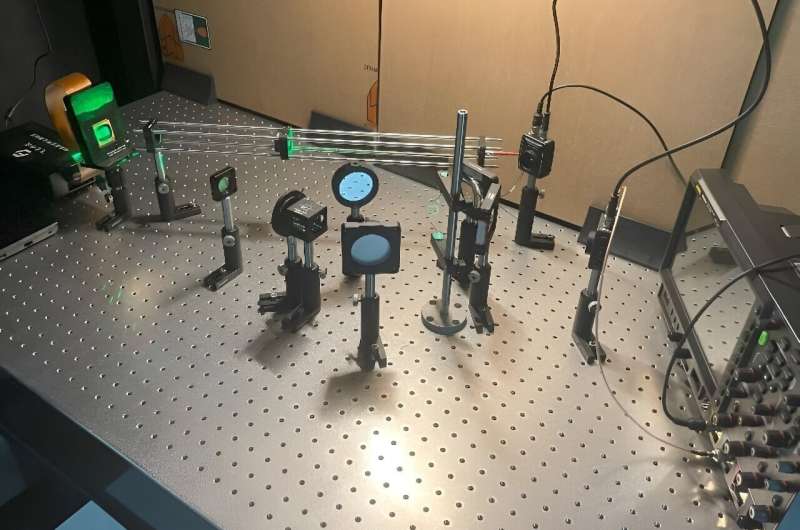This article has been reviewed according to Science X's editorial process and policies. Editors have highlighted the following attributes while ensuring the content's credibility:
fact-checked
peer-reviewed publication
trusted source
proofread
Researchers achieve practical 3D tracking at record-breaking speeds

Researchers have developed a new 3D method that can be used to track fast-moving objects at unprecedented high speeds. The real-time tracking approach, which is based on single-pixel imaging, could be used to improve autonomous driving, industrial inspection and security surveillance systems.
"Our approach does not require reconstructing the object's image to calculate its position, which significantly reduces data storage and computational costs," said research team leader Zihan Geng from Tsinghua University in China.
"Specifically, acquiring a 3D coordinate requires only 6 bytes of storage space and 2.4 µs of computation time. By reducing computational costs and improving efficiency, it could lower the cost of equipment needed for high-speed tracking, making the technology more accessible and enabling new applications."
In Optics Letters, the researchers demonstrate a tracking speed more than 200-times faster than traditional video-based methods. The tracking method doesn't require any prior motion information and can be performed with minimal computational resources.
"This technology could enhance the perception abilities of technologies like self-driving cars, improve security surveillance systems and offer more efficient monitoring and quality control for industrial inspection," said Geng. "Additionally, this high-speed localization technique can be used in scientific research, such as insect flight trajectory studies."
Improving usability
Single-pixel imaging is a computational method that acquires measurements using a single detector, rather than the traditional array of pixels. It typically involves illuminating a scene with a sequence of patterns and then measuring the corresponding intensity values with a single-pixel detector.
To create a more practical single-pixel imaging system for object tracking, the researchers implemented a non-orthogonal projection approach, which is more efficient than the orthogonal method typically used.
This involves projecting geometric light patterns onto two non-orthogonal planes, which creates 3D coordinates used to calculate the object's position. Non-orthogonal projection also reduces the overall system size, making it easier to assemble and implement.
High-speed tracking
After validating their method using simulations, the researchers conducted experiments using a single-pixel imaging setup that included a 532 nm laser for active illumination, a digital micromirror device (DMD) with a 20kHz modulation rate to create the light patterns and two single-pixel detectors to collect the light signals.
To test the tracking ability, they allowed a metal sphere with a central hole to move down a curved spiral wire under gravity while being illuminated with light patterns. They used the detectors' signals to calculate the object's 3D position and then used coordinate system rotation to obtain the calculated motion trajectory of the object.
With this approach, they achieved a tracking rate of 6667 Hz with the DMD at a modulation rate of 20kHz.
The researchers say that the primary challenge with this technology is that it can currently only be used to track a single object. They are now developing methods that will allow multiple objects to be tracked with single-pixel imaging.
More information: Huan Zhang et al, Prior-free 3D tracking of a fast-moving object at 6667 frames per second with single-pixel detectors, Optics Letters (2024). DOI: 10.1364/OL.521176
Journal information: Optics Letters
Provided by Optica




















